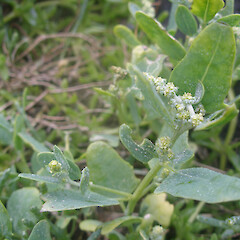Atriplex australasica
Common name
orache, saltbush
Synonyms
Atriplex patula var. gunnii Aellen, A. patula var. serratifolia Aellen
Family
Amaranthaceae
Flora category
Vascular – Native
Endemic taxon
No
Endemic genus
No
Endemic family
No
Structural class
Herbs - Dicotyledons other than Composites
NVS code
The National Vegetation Survey (NVS) Databank is a physical archive and electronic databank containing records of over 94,000 vegetation survey plots - including data from over 19,000 permanent plots. NVS maintains a standard set of species code abbreviations that correspond to standard scientific plant names from the Ngä Tipu o Aotearoa - New Zealand Plants database.
ATRAUS
Chromosome number
2n = 36-38
Current conservation status
The conservation status of all known New Zealand vascular plant taxa at the rank of species and below were reassessed in 2017 using the New Zealand Threat Classification System (NZTCS) – more information about this can be found on the NZTCS website. This report includes a statistical summary and brief notes on changes since 2012 and replaces all previous NZTCS lists for vascular plants.
Please note, threat classifications are often suggested by authors when publications fall between NZTCS assessment periods – an interim threat classification status has not been assessed by the NZTCS panel.
- Conservation status of New Zealand indigenous vascular plants, 2017 . 2018. Peter J. de Lange, Jeremy R. Rolfe, John W. Barkla, Shannel P. Courtney, Paul D. Champion, Leon R. Perrie, Sarah M. Beadel, Kerry A. Ford, Ilse Breitwieser, Ines Schönberger, Rowan Hindmarsh-Walls, Peter B. Heenan and Kate Ladley. Department of Conservation. Source: NZTCS and licensed by DOC for reuse under the Creative Commons Attribution 4.0 International licence.
2017 | At Risk – Relict | Qualifiers: RR, SO
Previous conservation statuses
2012 | At Risk – Naturally Uncommon | Qualifiers: RR, SO
2009 | At Risk – Relict | Qualifiers: SO, RR
2004 | Non-resident Native – Vagrant
Distribution
Indigenous. New Zealand: South Island (known from a 1770 collection from the Marlborough Sounds, possibly from two 1860 collections made from south Canterbury by Haast and Kirk), Chatham Islands (abundant). Also Australia (southern coast) and Tasmania.
Habitat
Strictly coastal. On the Chatham Islands it is usually found in open habitats such as along sand, shell, cobble or boulder beaches bordering the lagoon, on clay banks and cliff faces throughout the main island, particularly where near shag roosts, and commonly amongst sea-bird colonies and seal haul outs.
Detailed description
Annual much-branched, grey-green, glaucous to red-green, monoecious (?gynodioecious) shrub up to 1 × 2 m. Main stems quadrangular, widely spreading to sub-erect, woody at base, otherwise firmly fleshy to succulent; deeply ribbed, stout up to 15 mm diameter, grey-green to glaucous at first becoming purple-red to maroon with age. Upper stems similar, though much branched, ribbed and more or less slender. Petioles stout, fleshy up to 20 mm long. Leaves 20–100 × 30–60 mm, grey-green, glaucous to red-green, very fleshy to almost succulent, broadly lanceolate, broadly-deltoid to broadly hastate, lamina of young plants more or less entire, usually with 1–2 deep forward projected lobes near base, these often present on one side, mature leaves entire or deeply though irregularly lobed to almost coarsely dentate, lobes broadly deltoid blunt ended, forward projecting; leaf-base broadly cuneate; apex obtuse, sub-obtuse to acute. Inflorescence leaves similar though smaller. Inflorescence long, spiciform, paniculate more or less arching and pendulous at fruiting. Flowers in dense glomerules, these at first continuous, become disjunct; upper glomerules usually subtended by small bract-like leaves. Male flowers with perianths 0.5–1 mm long; segments green with fine hyaline margin. Female flowers enclosed by bracteoles 1.5–1.8–(2) mm long at anthesis, sessile, rhombic-triangular to triangular hastate, usually entire, sometimes toothed or with protuberances. Fruiting bracteoles 3–4 × 2–5 mm, deltoid, fused near base, equal to subequal, entire or with 1–2 teeth, smooth or with warty protuberances, very fleshy, grey-green to glaucous at first becoming black and much-thickened with age, apices acute. Fruits dimorphic, enclosed within bracteoles, mostly 2.5–4 mm diameter, orbicular, laterally flattened, radicle basal, horizontal; pericarp loose, chartaceous often ruptured at fruit maturation. Testa glossy black, smooth.
Similar taxa
Atriplex patula L. with which it has been confused in New Zealand literature. It should be noted that many botanists regard both species as the same, in which case A. patula has priority. From A. patula s.s., A. australasica differs consistently by its much wider, often deeply toothed or lobed leaves. In immature or juvenile plants the leaves are often entire or lobed 1–2 times near the base. However, from the typical form of A. patula seen in New Zealand, A. australascia differs by its more robust stature and much more fleshy-glaucous foliage.
Flowering
November–April
Flower colours
Green
Fruiting
December–May
Life cycle
Spongy nutlet dispersed by water and possibly also wind and granivory (Thorsen et al., 2009).
Propagation technique
Unknown. However probably easily grown from fresh seed and semi-hardwood cuttings.
Threats
Uncertain. Only recently rediscovered on the Chatham Islands where it is very common.
Etymology
atriplex: From an ancient Latin name whose derivation is uncertain, but a possible explanation is the name comes from the Greek a- ‘without’ and traphein ‘nourishment’ because many of these species grow in arid desert soils
australasica: Of or from Australasia
Where to Buy
Not commerciailly available.
Attribution
Fact sheet and description prepared for the NZPCN by P.J. de Lange July 2007
References and further reading
Thorsen MJ, Dickinson KJM, Seddon PJ. 2009. Seed dispersal systems in the New Zealand flora. Perspectives in Plant Ecology, Evolution and Systematics 11: 285–309. https://doi.org/10.1016/j.ppees.2009.06.001.
NZPCN Fact Sheet citation
Please cite as: de Lange, P.J. (Year at time of access): Atriplex australasica Fact Sheet (content continuously updated). New Zealand Plant Conservation Network. https://www.nzpcn.org.nz/flora/species/atriplex-australasica/ (Date website was queried)








